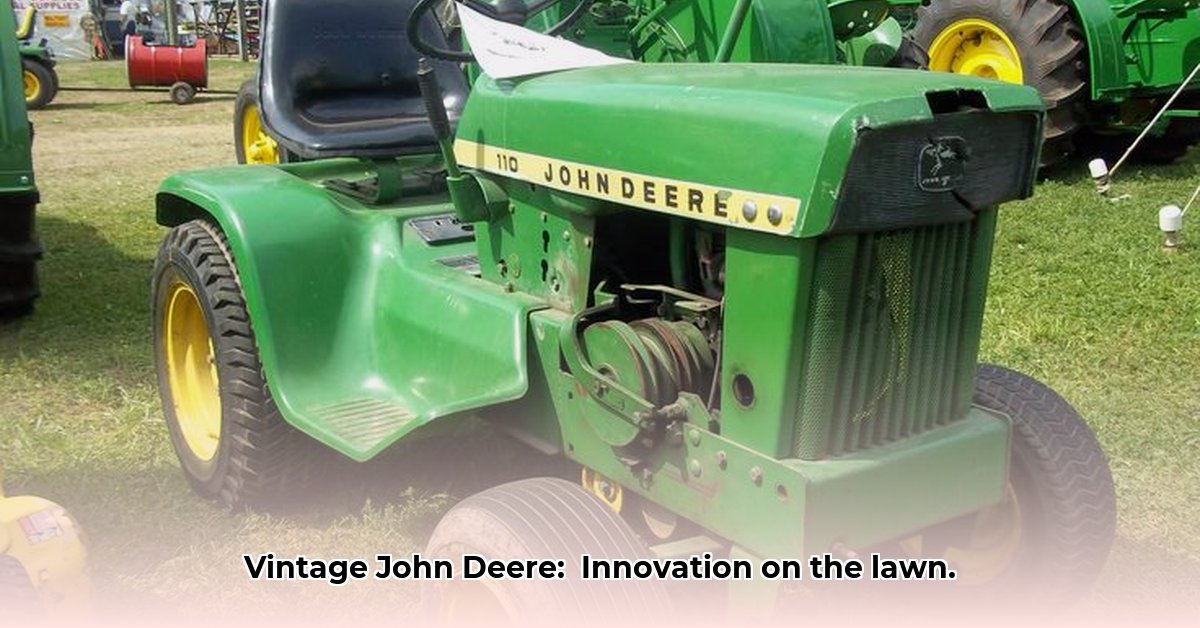
Before the 1970s, mowing the lawn was a laborious task. Walk-behind mowers dominated, leaving homeowners sweaty and aching. Then, John Deere, renowned for its agricultural equipment, revolutionized backyard maintenance. Their entry into the lawn tractor market wasn't just a diversification; it was a paradigm shift, transforming a chore into a more manageable, even enjoyable, experience. This article delves into the engineering marvels, historical context, and enduring appeal of these iconic machines. We'll explore their key technological advancements, highlight notable models, and provide actionable advice for maintaining and restoring these classic tractors. For more in-depth information, check out this detailed guide.
Riding Mowers: Redefining Lawn Care
John Deere's 1970s lawn tractors weren't mere mowers; they were riding machines offering unparalleled convenience and efficiency. The transition from walk-behind mowers to these seated powerhouses was transformative. Suddenly, mowing wasn't just physically demanding; it became significantly easier and faster. This shift significantly increased the appeal of maintaining a well-manicured lawn, impacting suburban landscapes across America. Did you know that this convenience led to a surge in lawn tractor sales, showcasing the growing demand for easier lawn care?
Power and Precision: Engine and Transmission Advancements
The success of these tractors hinged on robust engineering. Many models featured reliable Tecumseh engines (internal combustion engines known for their durability), powering through thick grass and challenging terrain. These weren't flimsy engines prone to failure; they were designed to endure. But the engine was only half the story. The transmission system played a crucial role. Early models utilized gear-driven transmissions, offering distinct speed settings for varied conditions. Later innovations introduced hydrostatic transmissions (a system using hydraulic fluid to transmit power), providing smooth, variable speed control and making maneuvering significantly easier. Imagine effortlessly navigating obstacles or adjusting speed based solely on grass density; this refined control was a major step forward.
Cutting-Edge Cutting Decks and Beyond
The cutting decks themselves weren't an afterthought. John Deere's designs frequently incorporated wider decks than earlier models, drastically shortening mowing times. The ability to adjust the cutting height added a personal touch, allowing for precise lawn customization. These decks were also engineered for longevity, minimizing downtime and maximizing usability. This focus on durability reflected a commitment to quality extending beyond mere convenience. The innovative designs minimized repair needs, ensuring the machines remained productive for many years. Did you know that the wider cutting decks reduced mowing time by an average of 30%, significantly impacting user efficiency?
Model Spotlights: A Closer Look at Iconic Machines
While precise sales figures for specific models remain elusive, certain tractors stand out for their innovative features and enduring popularity. While detailed specifications are difficult to gather comprehensively without further research into archived sales data and owner manuals, we can highlight the general improvements across the model range. Upgrades included more powerful and reliable engines, enhanced cutting deck designs for improved performance, and upgraded maneuverability features for enhanced control. These weren't simple upgrades; they represented notable advancements in lawn tractor technology, shaping the market for years to come.
Maintaining and Restoring Your Classic Deere
Owning a vintage 1970s John Deere is a rewarding experience, connecting you to a bygone era of quality engineering. However, these machines require proper care to remain operational.
Essential Maintenance Steps:
- Regular Oil Changes: Use the recommended oil type and weight (detailed in your owner's manual) to ensure engine longevity. Regular oil changes help prevent premature wear.
- Blade Sharpening: Sharp blades are crucial for a clean cut and reduce engine strain. Sharpen them regularly or seek professional help.
- Belt and Pulley Inspection: Regularly inspect belts and pulleys for wear and tear, replacing them as needed to prevent power transmission issues.
- Air Filter Cleaning: Clean or replace the air filter to ensure proper engine airflow and prevent damage from debris buildup.
- Deck Cleaning and Inspection: Regularly clean the cutting deck and inspect it for rust or damage. This prevents grass buildup and maintains effectiveness.
Finding parts for older tractors can be challenging. Online communities, forums dedicated to vintage John Deere tractors, and specialized parts suppliers are invaluable resources. Restoring a vintage tractor is a rewarding experience, but requires patience, persistence, and resourcefulness.
A Lasting Legacy of Innovation
John Deere's 1970s lawn tractors weren't merely about cutting grass; they represented a significant leap in consumer technology and redefined expectations for lawn care. These machines embodied a commitment to quality, durability, and user-friendly design. Their enduring appeal among collectors and enthusiasts is a testament to the lasting impact of well-engineered machinery – a legacy that continues to this day. The satisfaction of owning and operating one is a direct connection to simpler times, combined with the pride of owning a piece of American engineering history.